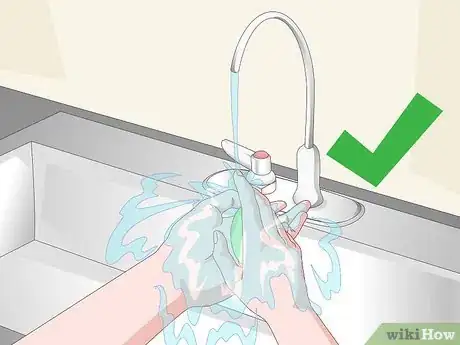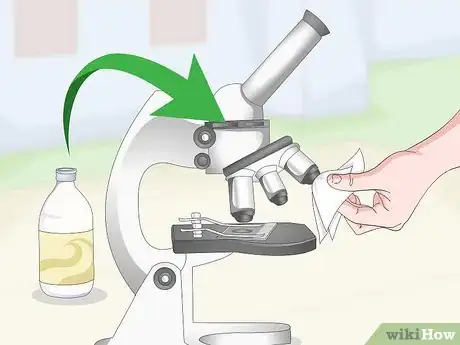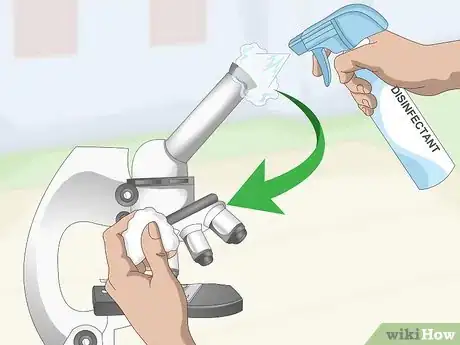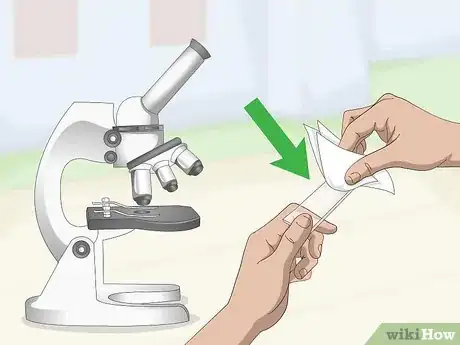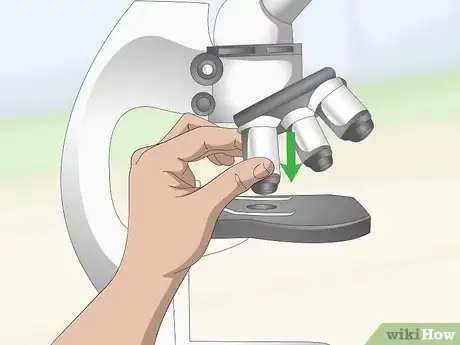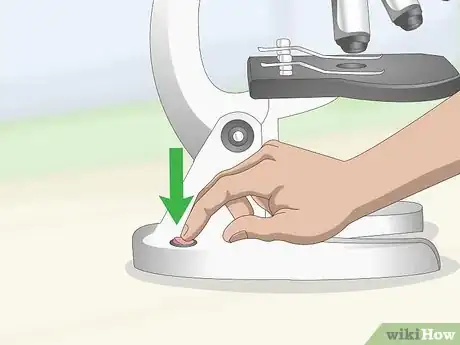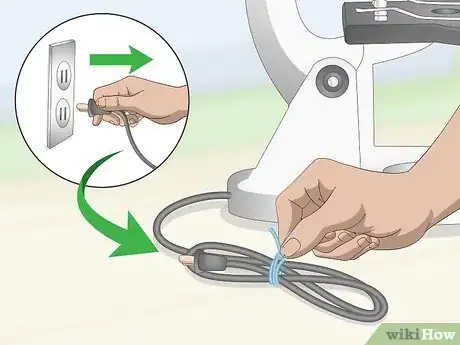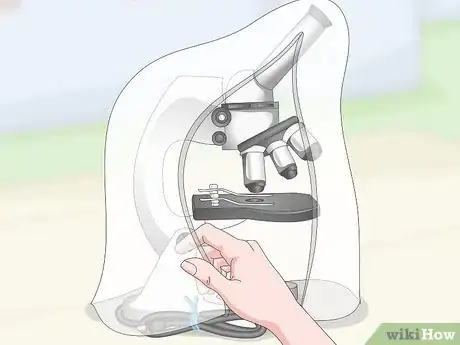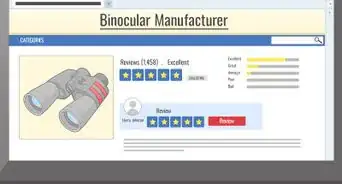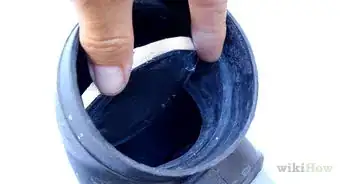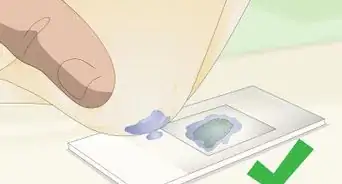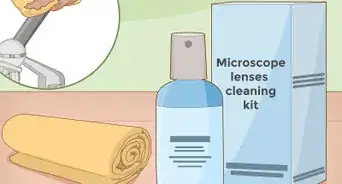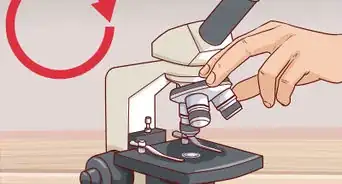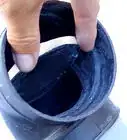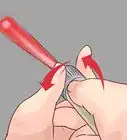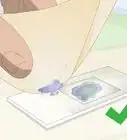X
This article was co-authored by wikiHow Staff. Our trained team of editors and researchers validate articles for accuracy and comprehensiveness. wikiHow's Content Management Team carefully monitors the work from our editorial staff to ensure that each article is backed by trusted research and meets our high quality standards.
This article has been viewed 31,531 times.
Learn more...
Microscopes are expensive and sensitive scientific instruments, so make sure you put yours away properly after you use it. Always avoid dust, clean the microscope and lenses, and replace the microscope’s dust cover. Doing these things will keep your microscope in pristine condition so you are ready for your next big discovery!
Steps
Part 1
Part 1 of 3:
Removing Dust
-
1Wash and dry your hands before handling your microscope. You want to make sure you are not spreading any dust or dirt to your microscope or its parts. Use soap and water to clean your hands, and dry them thoroughly with a towel.[1]
-
2Spray down your microscope with compressed air to remove dust. Spray the body of the microscope with the compressed air to clean it of any residual dust. Only spray the microscope’s body and surfaces--not the lenses.[2]
- You can purchase compressed air at an office supply store.
Advertisement -
3Clean your microscope with solution, lens paper, and lint-free cloth. Wet your lens paper or lint-free cloth with a cleaning solution, then wipe down the lenses and the body of your microscope. Move the cloth in a circular motion. Let your microscope air dry or wipe it with a lint-free cloth to prevent scratches caused from dust.[3]
- To clean the lenses, use lens paper or lens cleaning solution.
- You can use any cleaning solution to wipe down the body. Wipe down the tube, arms, stage, and base.
- You can purchase lens cleaning paper and solution at camera stores.
Advertisement
Part 2
Part 2 of 3:
Preparing the Microscope for Future Use
-
1Disinfect the eyepiece and nose piece. Your eyes, nose, and mouth easily spread germs, so make sure you wipe down the eyepiece and nose piece. Wipe down the nose and eye piece with a disinfectant cleaning solution and lint-free towel.[4]
- Disinfecting the microscope prevents the spread of germs or illnesses, like the common cold or the flu.
-
2Clean, remove, and store your microscope's slides. Remove the used slides from the microscope, wipe down the slides with a cleaning solution, and store them in a slide storage container or box. This will prepare the slides for their next use.[5]
- Make sure you remove any dirt or dust to prevent scratches.
-
3Put the objective lens and nose piece on the lowest power objective. Turn the coarse adjustment until the nose piece is on the lowest power objective. This keeps the microscope working properly for future use.[6]
- The lens may look blurry and out of focus. This is okay. You will adjust it into focus when you use it next.
-
4Turn the lenses to face your microscope’s stage. The stage is the part of the microscope where the slides are placed to view items. Using your hands, turn the lenses closer to the viewing area to safely store your microscope.[7]
- Moving the lenses makes the microscope more compact. This helps prevent any damages to the lenses.
-
5Turn off your microscope’s light. Switch the light off with the on and off switch, usually located on the back of your microscope’s base. Leaving the light on is a safety hazard.[8]
- The microscope's lightbulb can overheat and blow up if used constantly, so be sure you turn off your microscope to prevent damages.
-
6Unplug the cord, wrap it up, and secure it with a tie. To unplug, hold the plug of the illumination rather than the cord. Avoid unplugging from the cord to prevent damages to your microscope. Wrap up your cord and secure it with a tie to prevents accidents.[9]
- A loose cord can get caught on other items and cause you to drop the microscope in transport.
- Use a twist tie, zip tie, or cord tie.
Advertisement
Part 3
Part 3 of 3:
Storing Your Microscope
-
1Cover the body of your microscope with a microscope dust cover. Use the plastic cover to prevent dust from settling on your clean microscope.[10]
- Your microscope should come with a cover when you purchase it. If not, you can purchase one online or order one from a camera store.
-
2Protect your microscope by shutting the cover properly. Zip up the zipper or snap the clasps to secure the dust cover. This is an important step in keeping your microscope safe and dust free.[11]
- If your cover does not have a zipper or snaps, make sure it is covered completely by the dust cover. You can tuck the cover around the base to secure it in place.
-
3Store your microscope on a flat surface where it will not be disturbed. Keep your microscope on a flat surface so the parts are not damaged. The last thing you want is a passerby to knock over your microscope or a lens to break.[12]
- You can store your microscope on a table, cabinet, or shelf.
- Store your microscope in a plastic tub with a lid for extra protection against dust and damage.
Advertisement
Warnings
- Toilet paper, tissues, and paper towels have fibers that will scratch the lenses or glass. Always clean the microscope with a lint-free cloth to prevent damages.[13]⧼thumbs_response⧽
- Only use high quality, lint-free cleaning cloths on any optical surface. These parts are very sensitive and scratch easily. Organic solvents can cause damage or separation to the lens and coatings.[14]⧼thumbs_response⧽
Advertisement
Things You’ll Need
- Microscope
- Microscope cover
- Cleaning solution
- Disinfectant glass cleaner
- Lint-free cleaning cloth
- Compressed air
- Flat surface
References
- ↑ https://sciencing.com/store-microscope-4884280.html
- ↑ https://sciencing.com/store-microscope-4884280.html
- ↑ https://www.microscopeworld.com/t-microscope_maintenance.aspx
- ↑ http://www.microscope-detective.com/microscope-use.html#sthash.X2N7aXSD.HmE5vaEq.dpbs
- ↑ http://www.microscope-detective.com/microscope-use.html#sthash.X2N7aXSD.HmE5vaEq.dpbs
- ↑ http://www.microscope-detective.com/microscope-use.html#sthash.X2N7aXSD.HmE5vaEq.dpbs
- ↑ https://sciencing.com/store-microscope-4884280.html
- ↑ http://www.geog.ucl.ac.uk/resources/laboratory/light-microscopy/basic-rules-for-caring-for-microscopes
- ↑ http://www.geog.ucl.ac.uk/resources/laboratory/light-microscopy/basic-rules-for-caring-for-microscopes
- ↑ http://www.geog.ucl.ac.uk/resources/laboratory/light-microscopy/basic-rules-for-caring-for-microscopes
- ↑ https://sciencing.com/store-microscope-4884280.html
- ↑ https://sciencing.com/store-microscope-4884280.html
- ↑ http://www.cas.miamioh.edu/mbiws/microscopes/care.html
- ↑ http://www.geog.ucl.ac.uk/resources/laboratory/light-microscopy/basic-rules-for-caring-for-microscopes
About This Article
Advertisement
